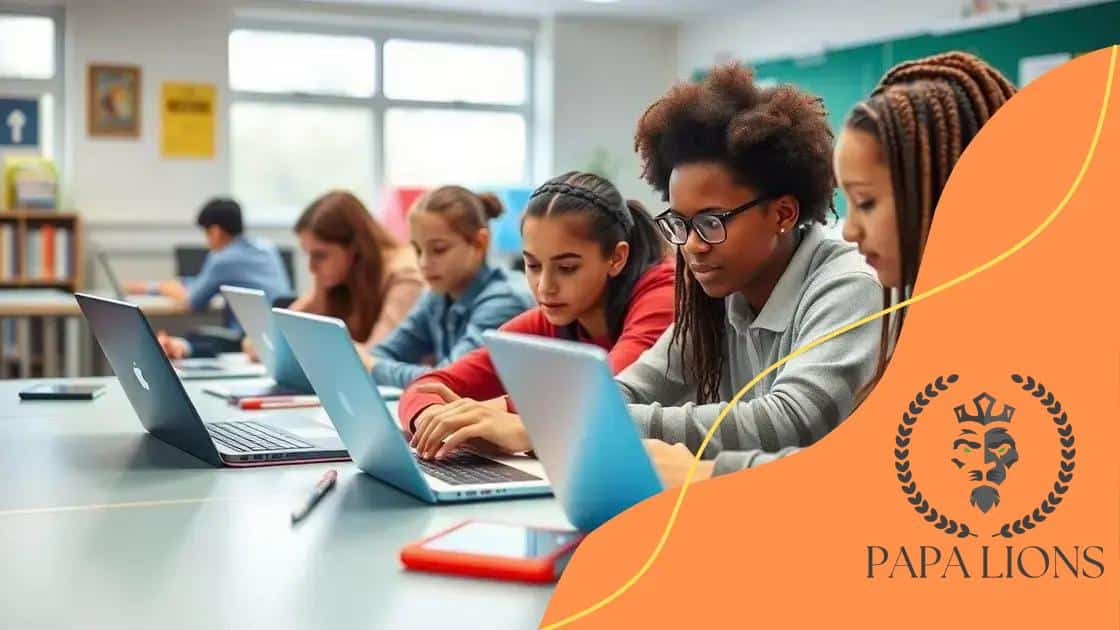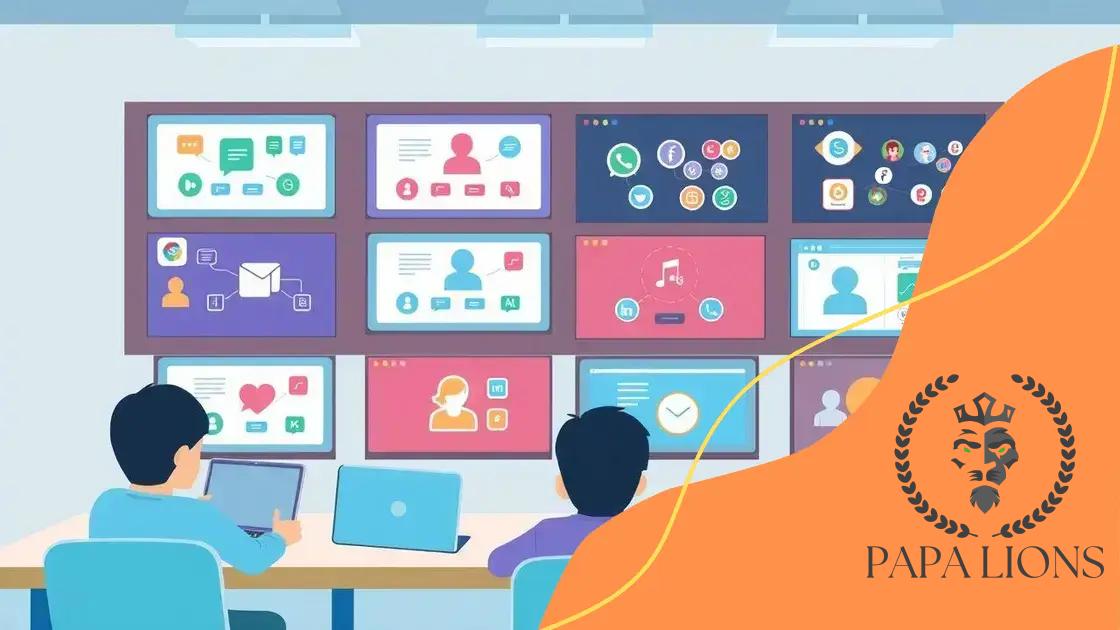Collaborative digital classrooms: unlocking new learning horizons

Collaborative digital classrooms enhance student engagement and learning by utilizing various digital tools that facilitate interaction, teamwork, and the ability to overcome challenges in online education.
Collaborative digital classrooms are changing the face of education as we know it. Have you ever considered how these interactive spaces can enhance learning experiences? Let’s dive in and explore.
Understanding collaborative digital classrooms
Understanding collaborative digital classrooms is essential for modern education. These innovative spaces enable students and teachers to interact effectively, breaking geographical barriers.
One important feature of these classrooms is real-time collaboration. Students can work together on projects using various digital tools, enhancing their learning experience. Let’s explore different aspects of these classrooms.
Key Features of Collaborative Digital Classrooms
These classrooms utilize technology in ways that transform learning. Here are some key features:
- Interactive Learning: Students engage with each other and the material dynamically.
- Instant Feedback: Teachers can provide immediate responses, helping students stay on track.
- Resource Sharing: Learners can easily access shared materials, making group work more efficient.
The impact of collaborative digital classrooms extends beyond academics. They also help in developing essential social skills. Students learn to communicate effectively, which prepares them for future professional environments. This collaborative approach fosters teamwork and enhances problem-solving abilities.
Benefits of Collaborative Learning
There are numerous benefits tied to the collaborative learning experience. Some of the most prominent include:
- Increased Engagement: Students are more invested in their learning when they collaborate.
- Diverse Perspectives: Working with peers allows students to see different viewpoints, enriching their understanding.
- Improved Retention: Learning through collaboration often leads to better retention of information.
Furthermore, collaborative digital classrooms adapt to the needs of individual students. This personalization is crucial in meeting diverse learning styles. By offering a variety of tools and approaches, educators can ensure every student gets the most out of their experience.
Key benefits for students and educators
The key benefits of collaborative digital classrooms are evident for both students and educators. These innovative environments encourage engagement and participation, leading to enhanced learning experiences.
One major advantage is the improved collaboration among students. They learn to work together, share ideas, and solve problems as a team. This not only benefits their academic performance but also builds essential social skills.
Benefits for Students
Students in collaborative settings often show higher levels of motivation. They take ownership of their learning and feel more connected to their peers. Here are some specific benefits:
- Enhanced Critical Thinking: Collaborating allows students to discuss different viewpoints.
- Increased Engagement: Working together makes learning more enjoyable and interesting.
- Development of Communication Skills: Students practice expressing their ideas clearly while listening to others.
Moreover, these classrooms provide access to diverse resources. Students can explore new tools and technologies that enrich their learning experience. They also have opportunities to learn from each other, gaining insights that might not come from traditional methods.
Benefits for Educators
Educators also reap significant benefits from collaborative digital classrooms. These environments create opportunities for innovative teaching methods. They can easily incorporate various digital tools to enhance lessons. Some of the benefits include:
- Real-Time Monitoring: Teachers can oversee group activities and provide immediate feedback.
- Streamlined Communication: Sharing information and resources with students becomes easier.
- Professional Development: Educators learn new skills as they navigate digital tools and collaborate with peers.
This dynamic approach to learning fosters a supportive community. Both students and teachers thrive when they work together, creating a vibrant educational atmosphere.
Effective tools for digital collaboration

Utilizing effective tools for digital collaboration is crucial in enhancing the learning experience in collaborative digital classrooms. These tools facilitate communication, streamline workflow, and encourage engagement among students and educators.
There are various tools available that cater to different aspects of collaboration. These platforms allow students to share ideas, work on projects together, and access resources seamlessly. Let’s explore some of the most effective tools that are empowering modern classrooms.
Popular Digital Collaboration Tools
Several tools have gained popularity for their effectiveness. They help facilitate teamwork and enhance learning outcomes. Some of these include:
- Google Workspace: This suite offers applications like Docs, Sheets, and Drive, allowing real-time collaboration.
- Microsoft Teams: A platform that combines chat, video meetings, and file sharing, perfect for class projects.
- Miro: An online whiteboarding tool that helps teams brainstorm and visualize ideas together.
In addition to these tools, educators can also leverage project management platforms to organize tasks and deadlines. Using these tools can simplify project-related communication and help keep students accountable.
Benefits of Digital Collaboration Tools
The benefits of using these tools in collaborative classrooms are significant. Students find it easier to work together and build on each other’s ideas. Here are some notable advantages:
- Accessibility: Students can access materials anytime, anywhere, promoting flexibility in learning.
- Enhanced Engagement: Interactive features encourage participation and make learning fun.
- Improved Organization: Tools keep projects organized, making it easier for students to manage their work.
By integrating these tools into classroom activities, educators provide students with valuable skills that they can use in their future careers. Digital collaboration not only enriches the learning experience but also prepares students for a world where teamwork and technology play a critical role.
Best practices for implementation
Implementing collaborative digital classrooms effectively requires careful planning and execution. Adopting best practices can significantly enhance the learning experience for both students and educators. This involves setting clear objectives and ensuring that everyone is on the same page.
One of the first steps in successful implementation is to assess the needs of your classroom. Understanding the specific requirements of students and educators is critical. This assessment will help you choose the right tools and strategies for collaboration.
Developing a Clear Framework
Having a framework in place provides a structured approach to collaboration. This framework should include:
- Defined Goals: Clearly outline what you aim to achieve with digital collaboration.
- Technology Training: Offer training sessions for both students and educators on the tools being used.
- Communication Guidelines: Set up rules for interaction, so everyone understands expectations.
These elements ensure that all participants are prepared and know how to engage within the collaborative environment. Additionally, regular check-ins can help monitor progress and make adjustments as needed.
Encouraging Student Engagement
Engaging students is essential for a collaborative classroom to thrive. Encouraging participation can be achieved by:
- Fostering a Safe Space: Create an environment where students feel comfortable sharing their ideas.
- Incorporating Interactive Activities: Use quizzes and group projects to maintain enthusiasm and interest.
- Offering Choices: Allow students to select topics or tools they feel most connected to.
These strategies help students feel more involved in the collaborative process and promote a sense of ownership over their learning. When students actively participate, the overall educational experience becomes more dynamic and enriching.
Challenges and solutions in online learning
Online learning presents unique challenges for both students and educators. Understanding these obstacles is essential for creating successful collaborative digital classrooms. Recognizing the issues allows for better strategies and solutions to emerge.
One common challenge is maintaining student engagement. Online environments can sometimes make students feel isolated, which affects their motivation. To offset this, educators can implement interactive activities that foster connection and participation. Using features like breakout rooms during virtual meetings can enhance collaboration among students.
Technical Issues
Technical difficulties can also hinder the learning experience. Problems such as slow internet connections or software glitches can disrupt lessons. It’s crucial for schools to provide support and resources to overcome these hurdles. Solutions may include:
- Providing Technical Support: Offering help desk services for students and teachers can resolve issues quickly.
- Training on Tools: Conducting training sessions on digital tools helps everyone become more confident in using technology.
- Creating Backup Plans: Having alternative methods for instruction ensures continuity in learning in case of technical fails.
The importance of clear communication cannot be overstated. Misunderstandings can arise in online settings, leading to confusion. Establishing regular check-ins helps keep everyone aligned and informed. This practice encourages students to express their concerns and ask questions freely.
Addressing Diverse Learning Needs
In a digital classroom, meeting diverse learning needs can be challenging. Students have different paces and styles of learning. To tackle this issue, educators can:
- Offer Flexible Learning Options: Allow students to choose how they navigate their learning paths.
- Utilize Various Formats: Incorporate videos, readings, and interactive activities to cater to different preferences.
- Encourage Peer Support: Create opportunities for students to help each other, facilitating collaborative learning.
By addressing these challenges with thoughtful solutions, online learning can be enhanced. Proactive measures contribute to a positive and enriching educational experience for all.
FAQ – Frequently Asked Questions about Collaborative Digital Classrooms
What are collaborative digital classrooms?
Collaborative digital classrooms are online learning environments where students and teachers interact dynamically using various digital tools, enhancing engagement and teamwork.
What challenges do students face in online learning?
Students may struggle with maintaining motivation and engagement, experiencing technical difficulties, and feeling isolated from their peers.
How can educators enhance student engagement?
Educators can enhance engagement by incorporating interactive activities, using breakout rooms, and fostering a supportive environment for sharing ideas.
What tools can improve collaboration in digital learning?
Tools such as Google Workspace, Microsoft Teams, and Zoom can facilitate communication and collaboration, helping students work effectively in group projects.





